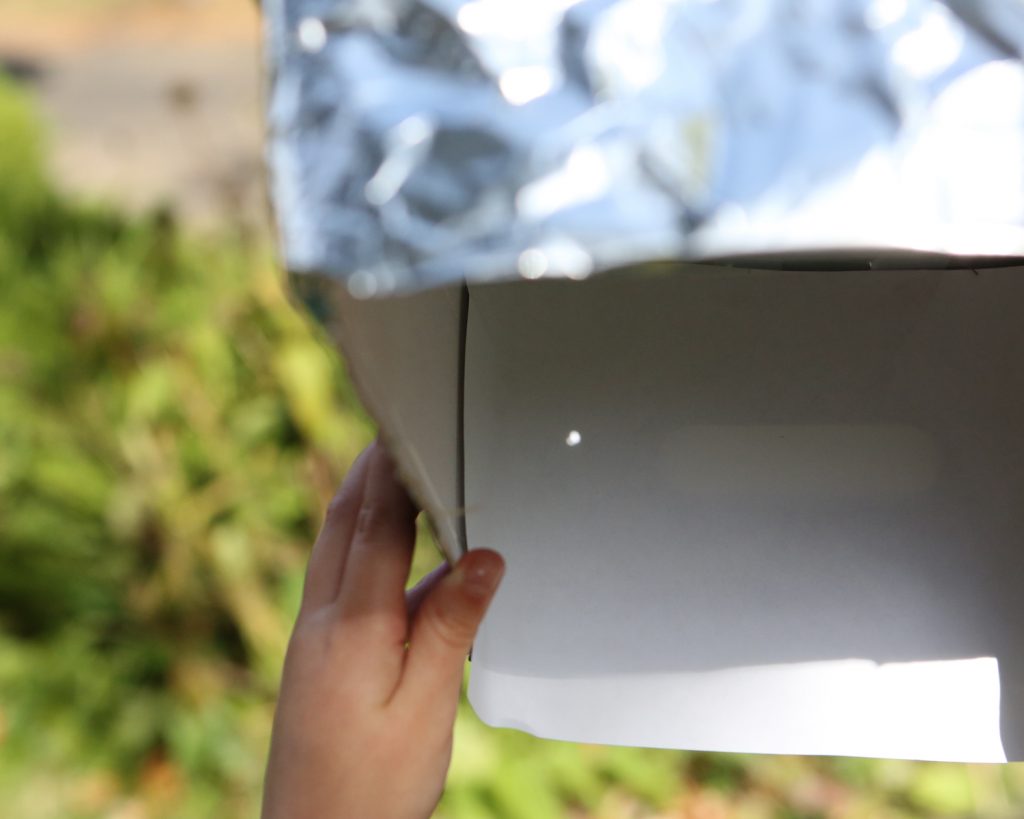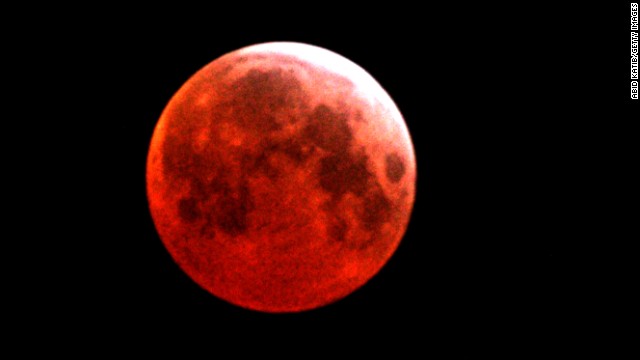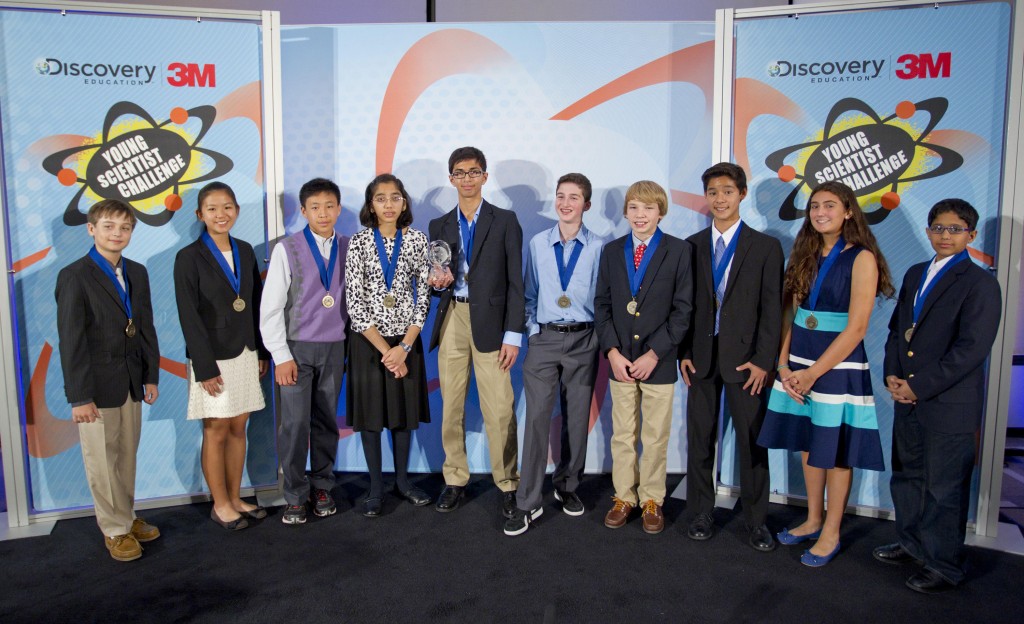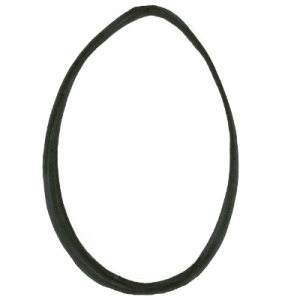Category:Science News’
Six Cool Facts about the 2017 Total Solar Eclipse
- by KitchenPantryScientist
In less than two weeks, the kids and I will hit the road to venture into the path of totality of the August 21st total solar eclipse. We’re hoping for clear skies in St. Joseph, MO, so that we can stand under the moon-darkened sky and catch a glimpse of the Sun’s corona.

Pinhole Solar Viewer- Kitchen Science Lab for Kids (Quarry Books)
NASA’s website is one of my favorite science resources, and they have tons of great information on the upcoming total solar eclipse. Check it out to learn when and where you can watch the eclipse, and how much of the Sun will be covered up in your back yard.
To safely watch the eclipse without damaging your eyes, you’ll need National Science Foundation-approved solar viewing glasses. If you don’t have glasses, you can easily view it indirectly by making a pinhole viewer. Here’s a link to an article I wrote for Scholastic Parents on how to build a solar viewer using a shoe box and some aluminum foil.
The Exploratorium in San Francisco has a fantastic Total Solar Eclipse 2017 app that you can download for more resources and to watch the eclipse live.
Here are some of the coolest things I learned about total solar eclipses from NASA’s website:
1: During a total eclipse, it’s possible to see bright stars and planets, even in the middle of the day. (I knew it would get dark, but that’s amazing!)
2. The Sun is 400 times wider than the Moon, but it’s 400 times farther away, so they appear to be the same size if you’re looking at them from Earth. That’s why the Moon can completely cover the sun. Scientists describe this by saying that they have the same angular size.
3. If you’re in the path of the total eclipse and place a large sheet of white paper on the ground, you may see dancing “shadow bands” moments before and after the eclipse, which are created by tiny slivers of sunlight passing through the currents of Earth’s atmosphere.
4. The temperature in areas of the Moon’s shadow will briefly drop as the Sun’s light is blocked.
5. The only popular song that refers directly to an actual solar eclipse is Carly Simon’s song “You’re so Vain.” (1970 total solar eclipse in Nova Scotia) (Around 3:05 in the song.)
6. Just before a total solar eclipse, you can see flashes of light called “Bailey’s Beads”around the edges of the dark circle of the Moon. They’re caused by sunlight flashing through canyons on the Moon’s surface.
Will you be watching? The next total solar eclipse won’t traverse the continental United States until April, 2024.
Discovery Education 3M Young Scientist Challenge for Kids in Grades 5-8
- by KitchenPantryScientist
I don’t typically write sponsored posts, but I love this contest so much that I’m more than happy to spread the word about it! Last year, I was lucky enough to hear the ten Young Scientist Challenge finalists present their innovations and was blown away by their creativity, their knowledge, and their passion for helping create a better world for everyone to live in.
The Discovery 3M Young Scientist Challenge “targets students in the years when research indicates their interest in science begins to fade and encourages them to explore scientific concepts, apply those concepts to everyday life and creatively communicate their findings.”
My 8th grader fits this description. He loves science, but hasn’t had opportunity to do much hands-on experimentation at school, and he’s bored. Last year, he entered the Young Scientist Challenge and came up with a tornado protection blanket made using a non-Newtonian fluid. He didn’t make it to the finals, but the fire was kindled. He was blown away by the finalists’ presentations and how much his peers knew about science and technology. Now, he tells me that he thinks about the 3M Young Scientist Challenge almost every day and seems determined come up with an idea that will take him to the finals this year for a shot at the $25,000 grand prize!
Whether he makes it to the finals or not, I couldn’t be happier. He’s engaged, he’s excited, and he’s working to think creatively.
Anyone in grade 5-8 can enter! Share the science behind a possible solution to an everyday problem in a 1-2 minute video at www.YoungScientistChallenge.com. Entries are due by April 21, 2015!
Hints for kids entering the contest: First of all, watch the finalists’ entry videos from last year! Then, think about a problem that needs solving, which is always a great exercise, whether you’re thinking locally or globally! If you’re stuck, read the news, make a list of problems and choose the ones you’re most interested in. Then, read more about the issues and brainstorm solutions. Remember, you’re not being graded and that there are no wrong answers.
Hints for parents: You’re only there to guide your kids, and remind them that some ideas (i.e. new ways to kill Ebola) may be too unsafe to investigate at home. You’ll be amazed at how smart they are!
The ten finalists in the Discovery Education 3M Young Scientist Challenge will each be paired with a 3M scientist mentor. The mentors will help guide finalists to create an innovation that will be presented to a panel of judges at the final competition at the 3M Innovation Center in October.
Follow the competition on Twitter at @DE3MYSC and on Facebook at https://www.facebook.com/YoungScientistChallenge
On Twitter? Join in Thursday evening, March 5 at 9 PM Eastern for the March #STEMchat. TheMakerMom.com is partnering once again with the premiere science competition for middle school students, the Discovery Education 3M Young Scientist Challenge. This year, the theme for our chat is applying science to everyday life. (This post is sponsored by #STEMchat.)
SpaceX Dragon and Lunar Eclipse
- by KitchenPantryScientist
It’s a big day for science lovers!
Not only will there be a total lunar eclipse in the wee hours of Tuesday morning (around 2:00-3:30 a.m. Central Time), but this afternoon at 4:58 p.m. Eastern Daylight Time (3:58 CDT) a SpaceX/Dragon Cargo Craft will launch from Cape Canaveral, FL to the International Space Station!

A lunar eclipse will be visible early Tuesday morning from much of the United States. Image from CNN.com.
The SpaceX rocket will carry SpaceMicrobes from project MERCCURi and space veggies, among other science projects. You can watch launch coverage from 2:45PM – 5PM CST on NASA TV.

A bacterium we swabbed on the set of Kare11 Sunrise is headed to the space station!
I’d love to write more, but am busy proofreading lasers of my Kitchen Science Lab for Kids book, that comes out Aug.1 and getting ready to go on Kare11 Sunrise tomorrow morning to show viewers how to grow crystals in eggshells!
NASA’s Curiosity Rover Lands on Mars!
- by KitchenPantryScientist
I stayed up until after midnight watching NASA TV’s coverage of Curiosity’s landing on the red planet. It was absolutely amazing and I hope kids everywhere will be inspired to study about space, planets and science in general. If you haven’t visited NASA.gov, you’re missing out on an amazing array of NASA websites dedicated to space and our very own Earth.

NASA image from Mars landing spot taken by Curiosity rover
Here’s the Mars Science Laboratory website, if you want to follow Curiosity’s mission!
Bubonic Plague in the News
- by KitchenPantryScientist
In 1348, Pope Clement VI’s physician wrote the following as the “Black Death” hit Avignon: “It was so contagious, especially that accompanied by spitting of blood, that not only by staying together, but even by looking at one another people caught it…The father did not visit his son, nor the son the father. Charity was dead and hope was crushed.” (From Deadly Companions by Dorothy H. Crawford)

Scientists have long suspected that the bacterium Yersinia pestis,which causes bubonic plague, caused the Black Death that killed over 30% of Europe’s population in 1347 and continued to burn through Europe for the next three hundred years. Two teams of scientists reported this week that not only was Yersinia pestis definitely the microbe that caused the Black Death, but that bubonic plague has its roots in China, where it has lived in fleas in the wild rodent populations for thousands of years. Humans are an accidental host of this deadly bacterium, but in three major waves it decimated the populations of Europe, Asia and Africa, causing the most dramatic fall in population ever recorded.
Y. pestis is carried by fleas, who are made ravenous by the bacteria and jump from rodent (often rats) to rodent looking for warm blood and injecting thousands of bacteria with each bite. As rats die, the fleas sense the cooling blood and jump to new victims. If the victim is human, they will probably be infected with bubonic plague and, if untreated with antibiotics (which they didn’t have during the middle ages), stand a pretty good chance of dying. If the infection goes to the victim’s lungs and they infect someone else by coughing on them, that person is as good as dead.
Bubonic plague eventually died out in Europe, but not before infected rats stowed away on ships traveling to the United States in the 1890s, where they arrived in San Francisco and quickly infected the squirrel population. Over 50 kinds of rodents in the Western U.S., Canada and Mexico are potential hosts for Y. pestisis and the bacteria is still surviving in these populations, from California to Colorado. Fortunately, as long as the disease stays in wild rodents and away from urban rat populations, it probably won’t cause many cases of plague in the U.S.A. (there were only 15 in 2006.) We’re lucky to live in the age of antibiotics, which can treat most cases of plague today.
What should you do if you don’t want to catch the “Black Death?” Avoid wild rodents like the plague.
How Malaria in Gorillas Affects You
- by KitchenPantryScientist
“Infectious agents — whether viruses or microbes — are constantly testing their environment for new host species to survive.” Beatrice Hahn, University of Alabama
Tiny organisms that can make us sick, known as microbes, are magicians at both changing and exchanging ways to survive in animal (and human) bodies. We have get new flu shots each year because H. influenzae, the flu virus, is constantly mutating. Salmonella enteriditis bacteria, which can infect eggs have received “injections” of genetic information from other bacterial species, which makes them more toxic to humans. Bacteria mutate often and trade antibiotic resistance like kids trade Pokemon cards.
One trick that makes microbes especially dangerous to us is their ability to occasionally jump from animal to animal, or animal to human. Our immune systems can often fight off infections that have been circulating through the human population over time, because we “recognize” the microbes trying to infect us. However, when a microbe jumps from animal to human, our bodies often don’t have the ability to recognize it or fight it off. (Researchers speculate that the 1918 Flu virus that killed over 40 million people may have been passed from birds to pigs, and then to humans.)
It is often even easier for a microbe to jump to a closely related species, like from chimpanzee to human, since we are so similar. To illustrate this idea, imagine a bacteria that usually infects circles. Chances are, it would be more likely to recognize and infect an oval than to infect a square. For a microbe to go from a chimpanzee to a human would be like going from circle to oval, while a jump from bird to human would be more like jumping from circle to square.
In the news this week, I learned that researchers have been racing to be the first to discover which of our primate relatives passed the parasite Plasmodium falciparum, which causes malaria, to the human population. This race comes on the heels of a paper showing that H.I.V. probably originated in monkeys over 32,000 years ago before being passed to chimpanzees, and then on to humans. A scientist named Beatrice Hahn, from the University of Alabama, along with many collaborators, won the race and demonstrated that the malaria parasite jumped from western gorillas to humans in a single leap, probably between 5,000 and 300,000 years ago.
We don’t worry much about malaria in the United States, but P. falciparum is a killer. According to the World Health Organization, or WHO ,”In 2008, there were 247 million cases of malaria and nearly one million deaths – mostly among children living in Africa. In Africa a child dies every 45 seconds of Malaria, the disease accounts for 20% of all childhood deaths.” If malaria has been around for over 5,000 years, we can only imaging how many people it has killed.
Hopefully, these findings will allow researchers to compare the original parasite, found in gorillas, to the modified one, found in humans and discover new avenues for preventing and curing the disease it causes. Maybe researchers will also gain more insight into how microbes jump from one animal to another, allowing us to prevent, or quickly halt diseases like malaria, H.I.V., or the 1928 flu before they become pandemics and kill millions of people.
What is Salmonella?
- by KitchenPantryScientist
More than half a billion eggs were recalled after Salmonella sickened over 1600 people (according to the Center for Disease Control, or CDC in September.) That’s a lot of eggs, and a lot of sick people.
What is this nasty bacteria that makes us wonder whether we should let our kids eat raw chocolate chip cookie dough, even as we sneak several spoonfuls when they’re not looking?
Salmonella enterocolitis is one of the most common types of food poisoning and is caused by the bacteria Salmonella Enteriditis. You can get a Salmonella infection by swallowing food or water that is contaminated with the salmonella bacteria. Often, the culprit is surface contamination from raw chicken and raw or undercooked eggs. In most people, it causes diarrhea, fever and abdominal cramping, but young children and those with weakened immune systems are at greater risk of dehydration and more serious infections.
Why don’t they just wash the eggs better? Salmonella bacteria live in the intestinal tracts of animals and birds and can infect the ovaries of healthy-looking chickens. This allows bacteria to infect the eggs even before the shell is formed and voila- you have a pathogen that can’t be washed off of the egg because it’s inside. Salmonella bacteria are often found in the “white” of an egg, although they can migrate to the yolk as the raw egg sits in your refrigerator. Organic and free range chickens have less disease than factory-“farm” raised chickens, partly because of healthier diets and less crowding. Cooking eggs until the yolk is solid kills Salmonella bacteria.
How can you make your cookie dough and eat it too? Buy pasteurized eggs (you can find them at most grocery stores) that have been heat-treated to kill bacteria, but are still essentially raw for all cooking and baking purposes.
Also, remember to wash cutting boards you’ve cut meat on with soap and water before cutting anything else on them, or just have separate cutting boards for meat. Don’t forget to wash your hands after handling raw eggs! Pet food and reptiles can also harbor salmonella bacteria, so have your kids wash their hand after handling either!
Bacteria are everywhere. Some keep you healthy and some make you sick, but making good decisions in the kitchen can keep you and your family from being affected by food-born illness!
Beneficial Bacteria: Our Best Defenders?
- by KitchenPantryScientist
Did you know that we have ten times more microbes in our bodies than human cells? It may sound gross, but these microbes are often more friend than foe and keep us healthy in return for a little space to call their own.
There was a fantastic article in yesterday’s Science Times about microbiomes- what scientists call the collection of microorganisms colonizing our bodies. The study of microbiomes has intensified in recent years and scientists are trying to catalog some of the bacteria we carry.
I eat yogurt filled with healthy, or beneficial, bacteria on a daily basis to keep a healthy population of these little helpers living in my gut. This keeps the bad bacteria from finding a place to take hold. A more extreme version of this was mentioned in the Science Times article, where a woman dying of an intestinal infection caused by pathogenic, or bad bacteria was saved when bacteria from her husband’s intestines was introduced into her large intestine. Within hours, the good bacteria had “kicked” the bad bacteria out, taking over residence.
I also learned that babies born by C-section (like my three kids) are more prone to skin infections and asthma, possibly due to the fact that coming from the sterile amniotic sac, they are colonized by bacteria from adults’ skin rather than that bacteria from their mother’s birth canal. In fact, people with asthma have a different set of lung microbes than healthy people and obese people have a different set of bacteria in their guts than people of normal weight.
You’ve heard that kids on farms and are exposed to dirt have healthier immune systems than city kids? It’s not the dirt itself, but the microbes in the dirt giving them their immune systems a boost.
There are years of hard work in the lab ahead of scientists to validate their beliefs that beneficial bacteria may one day be a weapon in the arsenal against infectious disease, but in the meantime, I plan to keep eating my yogurt and letting my kids play in the dirt.
Fun Science Contest for 6-12th Graders
- by KitchenPantryScientist
This morning, Twitter led me to a great website filled with science news for kids. Check it out at http://sciencenewsforkids.com/.
The Society for Science and the public, who sponsors the site, is having a contest for kids in grades 6-12 where they can enter their own podcast talking about what they’ve learned about science from the website. Go here for more details.
It sounds like a great way to keep your kids reading about science this summer!
We are the Whales
- by KitchenPantryScientist
Whale hunting has been in the new a lot recently, but it now appears that the biggest threat to these intelligent, majestic animals is no longer whalers’ harpoons.
I read this morning in the Star Tribune that “Sperm whales, feeding even in the most remote reaches of Earth’s oceans, have built up stunningly high levels of toxic and heavy metals.” Most of these contaminants have been introduced into the ocean by humans of course. The article goes on to talk about how our food supply is being threatened by our poisoned oceans and that seafood is a primary source of protein for over 1 billion people. Do you eat fish?
Apparently, high concentrations of these poisons collect in these whales because they are at the top of the food chain. That means they eat fish and squid that have eaten smaller animals, which have eaten yet smaller animals and plants and so on. Humans are also at the top of the food chain, and although we don’t only eat contaminated fish, we eat many other plants and animals that are exposed to heavy metals, pesticides and herbicides. Both whales and humans nurse their young, passing contaminants from mother to baby. (That beautiful piece of wild salmon may not be as pristine as you’ve convinced yourself that it is. Like it or not, our bodies are full of toxins too.)
What’s happening to the whales is happening to us. The difference is that the whales are not the ones polluting the world.
Look at the Gulf. Looks at our sick oceans. Go read “The Lorax.”
We have to save the whales to save ourselves.

